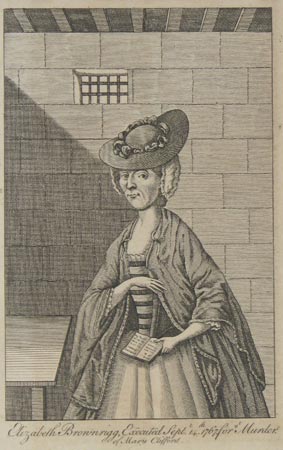 Every so often a story surfaces of such a horrible case of abuse that a nation is shocked by the tale. We are memorized by a person's cruelty and continue to retell of the abuse in the form of books or movies.
Every so often a story surfaces of such a horrible case of abuse that a nation is shocked by the tale. We are memorized by a person's cruelty and continue to retell of the abuse in the form of books or movies.Such was the case of the orphan servant girl, Mary Clifford.
When the Foundling Hospital (more on that later) opened it's doors to the orphans in London, it did so with the idea of teaching and reformation, in order to better society. Children would be apprenticed when they reached the appropriate age so that they could learn skills that would earn them a living. So that is how Mary Clifford and Mary Mitchell came to be in the service of Elizabeth Brownrigg as domestic servants.
Elizabeth had a good reputation as a working class woman. She was a respected midwife and her husband a successful plumber. Because of this she was chosen to overseen children training to be servants. One day the Foundling Hospital found a girl on their doorstep who they had entrusted to Elizabeth's care. She was frightened and had run away from her employer, complaining of abuse. After a medical examination the Governors found the girl was telling the truth and issued a warning to Elizabeth's husband, that if he didn't curtail his wife's violence upon her servants they would be forced to take action.
Shortly afterward a man was reading about the case in the newspaper when he realized his latest lodgers matched the description of Elizabeth and her son. He immediately contacted the constable and the Brownriggs were sent back to London to be brought to justice. The two Mr. Brownriggs were found guilty of misdemeanors and sentenced to six months in prison. Elizabeth did not get off so easy and was sentenced to death for her crimes of torture and murder. She was hanged at Tyburn and her body dissected for science (just as this Hogarth print shows, crime gets your body dedicated to science) and her skeleton was hung on display in the Surgeon's Hall as a reminder of the justice system.

Oh my goodness, how shocking! And it's disturbing to think that we read of similar stories in the newspapers of our own age.
ReplyDeleteAnyone remember the case just a year or two ago about the couple in New York who treated two immigrant employees in a very similar way? Here is the link; times haven't changed much, huh?
ReplyDeletehttp://www.thaindian.com/newsportal/uncategorized/indian-american-slavery-couple-sued-by-maids_10074855.html
Wow! That is horrible. It is amazing that people can be so cruel. I wonder what was done to Elizabeth to make her such a cruel person.
ReplyDeleteWow that is a similar story! It just goes to show history repeats itself, and unfortunately sick people are always around. I had just watched Changeling (Go see it if you haven't already btw) before I wrote this, and even those cases are similar, especially in terms of depravity.
ReplyDeleteThese were cruel times but some social responsibility was beginning to creep into it. Further back, nothing would have been thought of maltreating foundlings, the poor of the land.
ReplyDeleteThe anatomy lesson is a 'fanciful' depiction, probably designed to put fear into other possible felons.
Man's inhumanity to man is legend and continues, given half a chance to unleash, as we hear and see even today.
Very true point to bring up. The Foundling Hospital itself was an example of Enlightened thinking. Servants were as good as slaves for many years.
ReplyDeleteAlthough Hogarth's depiction is exaggerated (who, Hogarth? Exaggerated? pshhht) they would use felons' bodies for study, as they did with Elizabeth's. The thought of the body being dissected rather than buried was incentive to be on the good side of the law. I love how Hogarth shows the surgeons greedily dissecting an almost alive-looking cadaver, as if they can't get enough of the activity...mmm delicious and delightful dissection, we crazy surgeons just can't enough!
She reminds me of another sadistic lady of better breeding,
ReplyDeleteDelphine LaLaurie.
But, actually she was nothing compared to the
Countess Báthory the finest example of aristocratic cruelty.
@Fabulastic: Both links were interesting. I want to see the film Bathory now. It's in the queue.
ReplyDeleteYes! Bathory! She was a beast!
ReplyDeleteYou're all so bloodthirsty! ......er... where can I get a copy of the film about Countess Bathory? :O)
ReplyDeleteThe Countess is a German movie coming out about Bathory. It hits theaters next year, hopefully will hit American ones too!
ReplyDelete